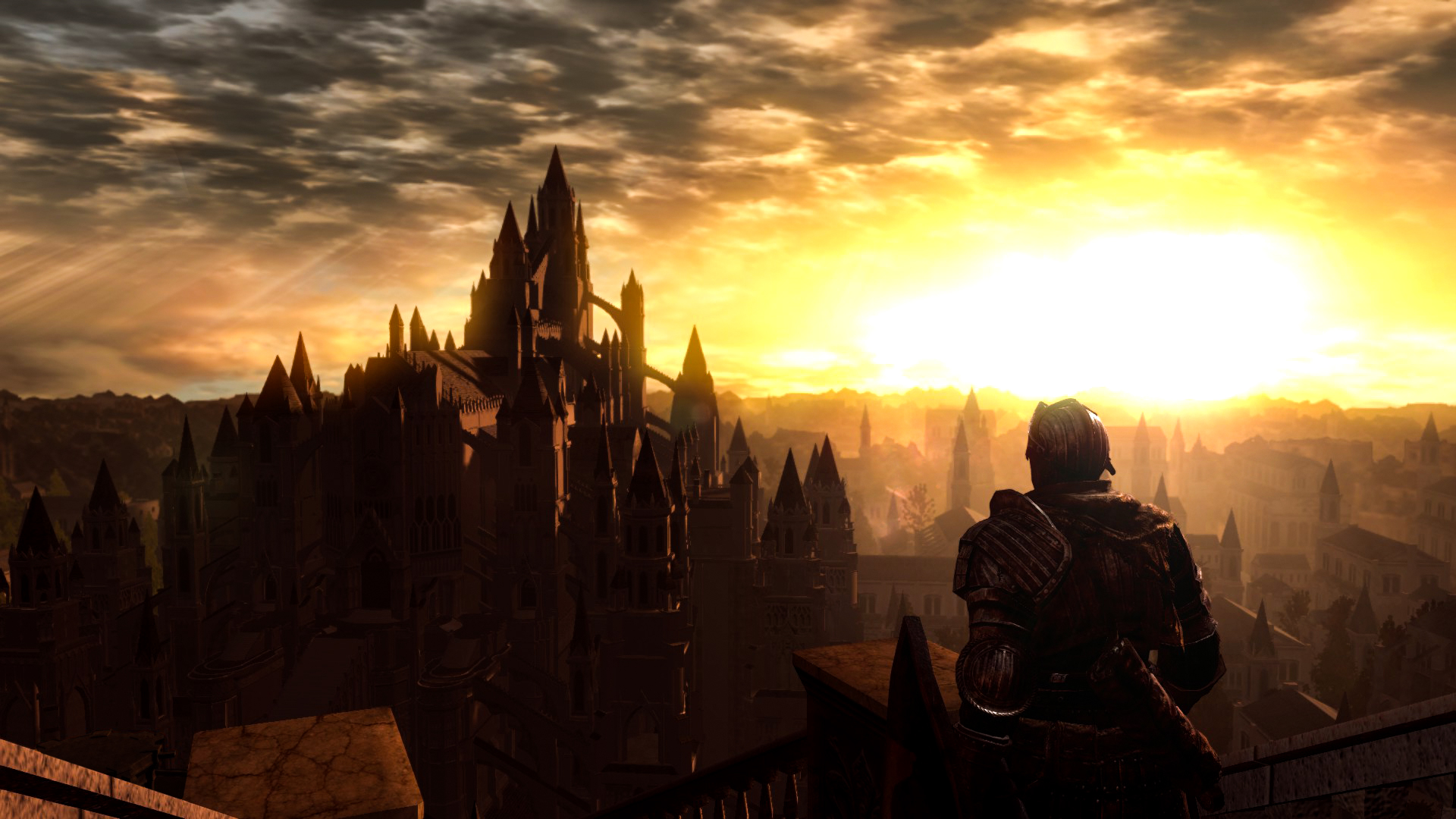Is Dark Souls Remastered worth playing without its former mystery?
How the mundane truth behind a secretive pendant keeps Dark Souls' world infinitely fascinating.

My impression reading online discussions about Dark Souls in September 2011 was this: no one trusted Dark Souls. And that was how I got hooked.
Dark Souls was once a tightly locked box of secrets. It’s since been unpacked, rather too thoroughly, and now it’s been remastered. But upon its release it was an enigma, a grand kind of meditation, an object of obsessive fascination. The world of Lordran is much vaster than what is contained within the game you buy on Steam. In my mind and in others’, the world sprawls in directions that will never load in.
I didn’t want to play Dark Souls in 2011. The marketing campaign was stupid. It was all about how you were going to die, and it wasn’t any more sophisticated than Daikatana’s promise that John Romero would make you his bitch. I didn’t want a game that promised to punish me.
But I played the thing anyway, and I beat the Taurus Demon. It made me feel alive, and willing to go on. But I didn’t want to lose all my souls and needed to know where to go next. So I visited some forums dedicated to discussing Dark Souls.
![The Taurus Demon [Source: Dark Souls Wiki]](https://cdn.mos.cms.futurecdn.net/VkjqYGifJP6VYUhxESaeEY.jpg)
At that point, a couple of days after the game’s launch, many were feebly asking: 'how do I beat the Taurus Demon?', or 'where do I go after the Taurus Demon?', or 'why do the skeletons come back to life?' Others were asking more fascinating questions. Overall, my impression reading online discussions about Dark Souls in September 2011 was this: no one trusted Dark Souls. Everyone was faintly scared. Everyone proceeded with the utmost caution. And that was how I got hooked.
It’s usually healthy to ignore what people say about video games in chat forums and on social media. I’ve found that paying too much attention to what other people say about games diminishes the pleasure of playing them. Games are weird and fascinating things: I don’t want to know if angryboy403 on GameFAQs takes issue with invincibility frames during dodge rolls. But I’ll always make an exception for Dark Souls games. In 2011, when Dark Souls first released for consoles, the communities that formed around it were the most positive and inquisitive I’ve ever encountered.
Talking about Dark Souls and reading about Dark Souls felt just as important as playing it. Much has been written about the collaborative aspect of Dark Souls, and it usually focuses on the game’s summoning system. But internet forums dedicated to Dark Souls, in September 2011 and in the months following, were the real proof that this game can bring strangers together in harmony. And not only that, it could bring strangers together to dream beyond the game.
Take the pendant, for example.
Keep up to date with the most important stories and the best deals, as picked by the PC Gamer team.
A simple pendant with no effect

Even so, pleasant memories are crucial
to survival on arduous journeys.
The pendant is one of a handful of gifts you can choose when starting the game. It’s useless. It does nothing—the game tells us this. Except no Dark Souls player back in 2011 believed it: there was a sustained and thorough online effort to discover what this pendant really did. It wasn’t until I witnessed others obsessing over the pendant that I realised how potentially bottomless this game really was. I stopped leaving the house, I stopped reading books, I slept significantly fewer hours. When I did sleep, I dreamed of Dark Souls and I dreamed of the pendant.
I had my own theory about the pendant. There’s a boarded-up passageway in the Lower Undead Burg, and I believed these boards could somehow be dismantled with some obscure use of the pendant. This boarded-up passage, which lay directly to the right if you enter the Lower Undead Burg near the pack of wild dogs, didn’t and still doesn’t look like window-dressing. If you peer through the boards at the right angle, a bleak cobbled road leads down a set of stairs, turns a corner, and leads… surely somewhere. Perhaps to the vast open air fields visible from the graveyard near Firelink Shrine and east of the New Londo Ruins.
I signed up for a GameFAQs account and posited this theory. It wasn’t especially well thought out, nor well received, but I was convinced that the boarded-up passage led somewhere, pendant-related or not. People who play a lot of games instinctively know whether a closed passage is window-dressing or a secret. Games are rife with closed doors and brambled paths that cannot be traversed, and few think twice before moving on. But this passage looked real to me.
![The passage. [Source: IllusoryWall]](https://cdn.mos.cms.futurecdn.net/8HE2DspvyxuGRsHtqxEQXR.jpg)
I didn’t get many replies. Everyone was too busy posting more feasible pendant theories. Here’s Pokerkid777, posting on GameFAQs back in 2012 in a Q&A style, and edited for clarity:
Q: What’s the point of this topic? The pendant is useless!
A: Normally, yes. However due to the developers recommendation of this item and the overall mystery of the so called ‘useless’ item, it has brought along many questions and theories of what is the true use of this pendant.
Q: The game has been out for months now. Wouldn't you think someone would have found the use by now?
A: The thing is that From also partook in another game called 3D Dot Heroes. There was this one hidden sign under a rock that took 255 times examining it to reveal the sign. This secret wasn't discovered until years after the game’s release. Many people believe that the pendant’s secret may be that well hidden.
Back in 2012 on GameFAQs, it was common for people to draw this parallel between the obscurity of the pendant’s use and that amusingly buried 3D Dot Game Heroes secret (3D Dot Game Heroes was a PS3 Zelda-like published by From Software in 2009). One theory that carried a bit of clout, on GameFAQs at least, was that the pendant was related to a secret covenant. User SadoSadoSado suggested that the reason murdered Rhea drops an identical pendant upon her death is because her murderer, Petrus, wanted to frame a secret covenant attached to the pendant (it’s a typically long winded theory, and I’m paraphrasing. You can read the whole thing here).
It wasn’t long after the game released for PC that year, that it was discovered that the pendant, indeed, did nothing.
User PURE_DESS presented a few of their own theories. The most boring was that it could provide access to Solaire of Astora’s covenant without needing to meet the Faith level requirement (easily debunked). More tantalising was the theory that it might hold the secret to accessing a secret boss in the Duke’s Archives. A rarer theory was that it could help defeat Seath the Scaleless upon his first appearance in the Duke’s Archive. And if you care to Google it, hundreds of these expired theories are spread across the internet, providing a glimpse of a time when Dark Souls had yet to be thoroughly vivisected.
The theorising was determined and sincere at first. Slowly, it became a meme. The more skeptical participants of the forums would use the pendant as a punchline in jokes, but for at least three months there endured a shrinking pool of players who were convinced that the pendant would unlock a secret in a game that had proven, already, that it had the capacity to hold much more than most players would ever see.
The theories are still all there for the perusing (Google it for fun), but the excitement is lost to time. The pendant has been proven useless. In 2012, speaking to a From Software developer at E3 via translation for CVG (RIP), I was laughed at for bringing up the pendant. I was told, basically, to give up. It was nothing. The same was told to Eurogamer. And it wasn’t long after the game released for PC that year that it was discovered that the pendant, indeed, did nothing.
The road

So the passage in the Lower Undead Burg leads nowhere. But during those early weeks spent playing Dark Souls, the game’s deep mystery and the careful interwoven design of its world helped me believe that it must. And not only did I imagine that it did lead somewhere, I also mapped out its destination in my mind. I imagined a whole area of Lordran exterior of the map, and I oriented this area around what I knew about the world. A game hasn’t inspired me to do this since I was a kid. What other modern blockbuster game has made us wonder as vividly as Dark Souls did upon release? What other modern blockbuster game has exercised our imaginations so fervently?
None, in my personal experience. Dark Souls copycats, whether Nioh or The Surge, are adept at emulating the banal aspects of the game (the difficulty, the combat), but they’re utterly hopeless at emulating its sense of the uncanny, its ability to expand beyond what is depicted on the screen. This is the driving factor behind my motivation to finish a game as challenging as Dark Souls.
The carrot on the stick isn’t better weapons, it isn’t better stats. It’s feeling out the world and speculating along the way. It’s wanting to see the next landmark. I could care less about the bosses.
Dark Souls is a catalogue of images and sensations for me. It’s no longer just a game.
Through its demand that players learn its map intimately, and through its willingness to withhold monumental areas most games would want to parade (see: the Painted World of Ariamis, Ash Lake), Dark Souls allowed its early players the freedom to dream beyond the map. If Dark Souls could hide the Great Hollow behind an innocuous secret wall, what the hell else is out there? Now, whenever I pass through the Lower Undead Burg, I imagine myself charting a path beside a vast, spectral area that exists only in my imagination. Meanwhile, others have exercised their imagination to make sense of the game’s notoriously opaque lore.
With the release of Dark Souls Remastered, most will be charting a path they’ve journeyed once or several times before. The mystery is lost. Even for those journeying for the first time, the internet will debunk errant theories all too quickly. Nowadays when we talk about Dark Souls we talk about PvP, we talk about builds and speedrun tricks, we know the game intimately. We can complete it using Rock Band guitars. There’s no way to revisit that period when no one knew what depths this game might contain, and there’s no way to sensibly believe there’s anything new to discover.
And while that’s all true, I’m thoroughly engrossed in Dark Souls again. I don’t want to replay games anymore: I have two kids and barely time to make a cup of tea. I have a long list of games I haven’t ever played. Dark Souls is a game I’m ecstatic to revisit, though. I know the limits of Lordran. I know there’s a hard, impenetrable threshold between the reality of the map and the parts I have dreamed.
But to revisit a world that triggered so much speculation and so much wonder is its own special joy. Dark Souls is a catalogue of images and sensations for me. It’s no longer just a game. And that’s why it’s already a classic: because it contains so much more than what’s in the files.

Shaun Prescott is the Australian editor of PC Gamer. With over ten years experience covering the games industry, his work has appeared on GamesRadar+, TechRadar, The Guardian, PLAY Magazine, the Sydney Morning Herald, and more. Specific interests include indie games, obscure Metroidvanias, speedrunning, experimental games and FPSs. He thinks Lulu by Metallica and Lou Reed is an all-time classic that will receive its due critical reappraisal one day.

